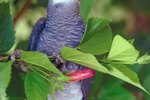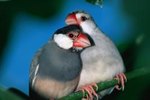
Many parrot species are brightly colored. Scientists believe that the birds' bright colors are the result of sexual selection. Feather colors are produced by pigmentation, light refraction against the feather's structure, or a combination of the two. Male birds are often more colorful than females, but in many parrot species both sexes are vivid.
A Parrot's Color Vision
Birds in general have excellent color vision. Parrots have better color vision than humans; some can even see ultraviolet, a color undetectable to the naked human eye. They can see differences in feather colors that are similarly undetectable to humans. Parrots can identify other birds' species and sex by their colors.
How Colors Affect Courtship and Mating
When breeding, a parrot will choose a mate with bright, vibrant colors. Brighter colors indicate a healthier bird. The most colorful males have a higher sperm count, and the most colorful females will produce larger, healthier clutches of young. Birds who are ill or infested with parasites often have comparatively dull feathers.
Using Bright Colors to Send Messages
Parrots use their bright colors to send messages to others. The female eclectus parrot uses her bright red color to warn enemies away from her nesting area. Parrots may use their colors to establish territory boundaries and to show their dominance over other parrots: brighter birds are generally stronger, and others will be leery of challenging them. Colors may also be flashed as a warning to other parrots in the colony about approaching dangers.
How Color Affects Juvenile Feeding
Parrots may use color and pattern recognition when feeding their young. Parrot eggs hatch on alternate days, so that the babies' ages and sizes vary. Older juveniles require more food than the smaller, younger parrots. Parents often use the brightness around the edges of their babies' open mouths and the brightness of their head feathers to indicate who needs the most nourishment.
How Color Affects Camouflage Ability
Parrots' bright colors can make them more visible to predators. However, many wild parrots live in a rainforest environment, and are camouflaged when they're among the vividly colored flowers, fruits and berries of their home. Bright-green parrots can easily disappear among bright-green foliage. Because of the colorful environment they live in, parrots' brilliant colors are not always a disadvantage when they wish to hide.
References
- National Wildlife Federation: True Colors: How Birds See the World
- BirdChannel.com: Bird Health and Feather Color Changes [PDF]
- Wasatch Audubon Society: Lesson 2: Bright Colors
- The Cornell Lab of Ornithology: All About Birds
- The University of Western Australia: Lessons From Parrots' Vision to Help Human Eyesight
- BirdTricks.com: A Bird's 5 Senses
Resources
Photo Credits
-
Comstock/Comstock/Getty Images
Writer Bio
Karen Mihaylo has been a writer since 2009. She has been a professional dog groomer since 1982 and is certified in canine massage therapy. Mihaylo holds an associate degree in human services from Delaware Technical and Community College.



